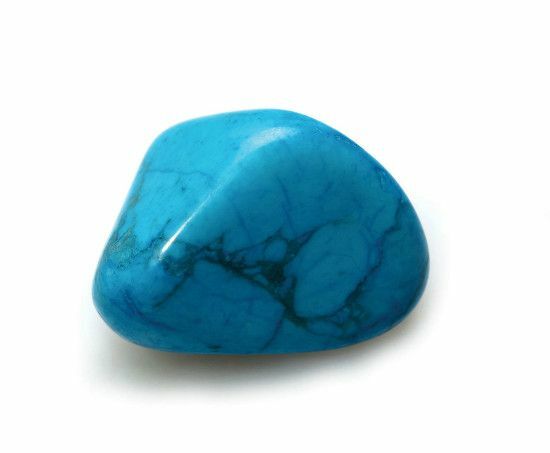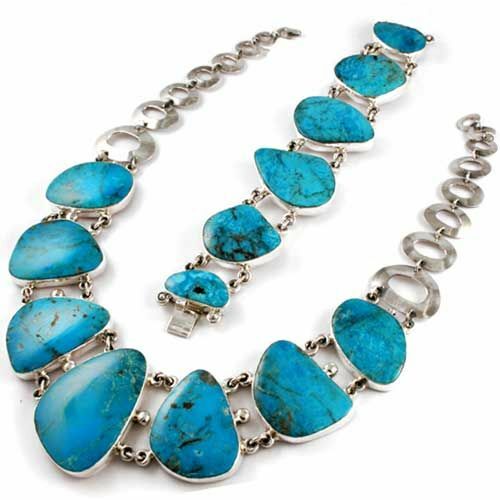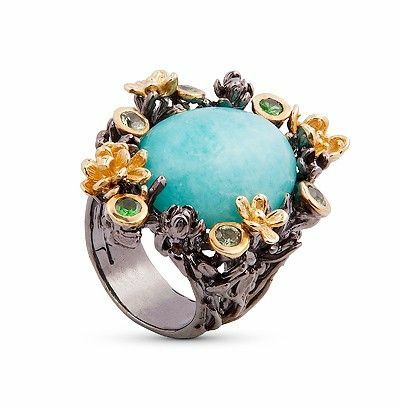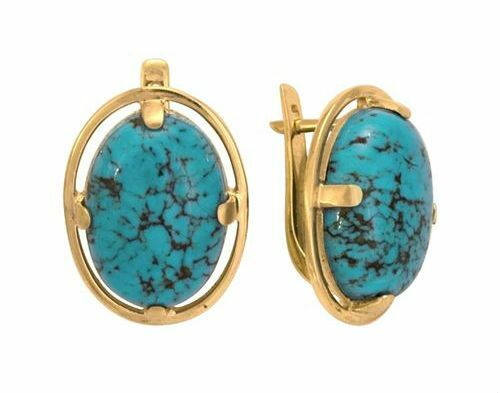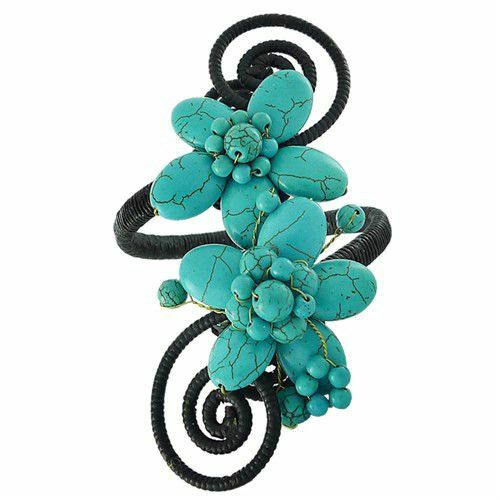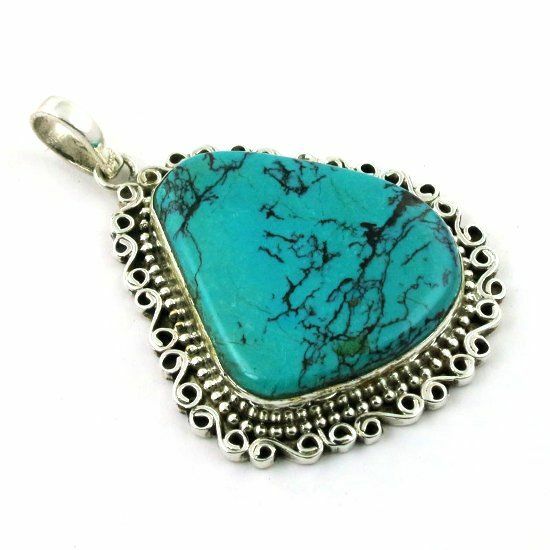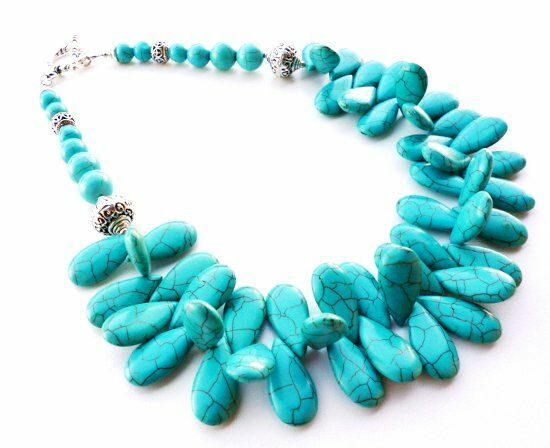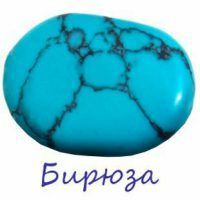
A stone of happiness, a stone of love and victory - in ancient times it was called turquoise, attributing to it various healing and magical properties.
This beautiful semiprecious ornamental stone was admired and admired, it was used to make original jewelry, as an amulet for attracting luck and victories. The popularity of gem does not diminish in our days.
Description of the mineral
Turquoise - opaque and non-translucent stone with matt inglossy luster and ornate pattern. The color of the stone is from gently blue to greenish. Interestingly, over time, turquoise is able to change its color. Over the years, the stone of a saturated blue color acquires a green, gray or even a brownish hue. Gemologists argue that such changes in the color of the mineral are due to the fact that over time his chemical formula changes, it "ages", and traditional healers claim that in this way the stone reacts to the illness of its owner.
The name of the stone "turquoise" has Persian roots and comes from the word "firuza", which translates as "the stone of happiness."There are other names for this mineral: Egyptian turquoise, celestial stone, Aztec stone, war stone, etc.
to the table of contents ^History of turquoise
The history of the application of turquoise and its special, respectable attitude to it is rooted in the distant past.
- In ancient Egypt for several thousand years before the Egyptian masters carved figurines of sacred beetles-scarabs from turquoise. These figures for the ancient Egyptians were the object of worship, they served as a powerful amulet to attract victories. No wonder turquoise in ancient Egypt was considered a stone of warriors and pharaohs. And captured for them turquoise prisoners and slaves, forced to work in difficult conditions of the waterless desert of the Sinai Peninsula.
- In the 1st century ADturquoise enthusiastically described the ancient Roman historian Pliny the Elder. He spoke of it as a stone, that "blue sky is heavenly."
- Turquoise was the sacred stone of the Indians. Especially it was worshiped by the Aztecs. This is evidenced by ritual masks and images of the gods, inlaid with turquoise, found during the excavations of the burials of the leaders of this people.
- Various ornaments and amulets from turquoise have also been found during excavations of ancient burials and settlements of other peoples of Central America and Central Asia. Read the turquoise in Iran, where in the III millennium BC.The best deposits of this stone were developed. He was very fond of the eastern shahs, who had many beautiful ornaments from turquoise. In those far times in Persia, it was a real national talisman. It was believed that turquoise can save a person from evil and attract a happy fate. Attributed to turquoise and various healing properties, so that no Oriental healer did not do without its use in his medical practice.
- Tibetans revered turquoise as a divine being endowed with special power.
- In special respect, turquoise has always been in the Muslim world. Being a symbol of purity, innocence and talisman of family happiness, she always decorated the wedding dresses of each bride.
- Indian doctors used turquoise as the best remedy for healing from throat and thyroid diseases.
- Russian rulers also loved turquoise. Tsar Ivan the Terrible considered this stone a panacea for all ills and ordered them to decorate one of their headdresses. And during the reign of Boris Godunov, the royal throne was decorated with pieces of oval-shaped turquoise.
Chemical composition and physical properties of mineral
As a mineral of sedimentary origin, the chemical composition of turquoise is a complex phosphate of aluminum and copper.
Its chemical formula is CuAl6( OH) 2PO4 4H2O.
The chemical composition of turquoise includes:
- copper oxide( CuO) - about 9.57%;
- alumina( Al2O3) - 36.84%;
- water( H2O) - 19.47%.
In addition to the basic chemical elements in turquoise, various impurities can be found. The main ones are:
- zinc( Zn) - its content is about 3%;
- vanadium( V) - 0.1-0.5%;
- silicon( Si) - 0.05-5%;
- calcium( Ca) - about 1%.
The color of the mineral depends on the chemical composition and the percentage of various impurities. It can be either sky-blue, greenish, grayish or brownish. The main role in determining the color of turquoise is played by the content of copper.
Turquoise coloration is usually inhomogeneous, with inclusions and veins of brown or black color, due to the presence of iron oxides and manganese.
When heated, turquoise loses its color, becomes dark brown and cracked, and dissolves in hydrochloric acid.
This is a relatively soft mineral, it can be easily processed and does not crumble. The hardness of turquoise on the Mohs scale is from 5 to 6, and the density is from 2.6 to 3 g / cm3.
Over time, in the process of "aging", the chemical composition of turquoise produces hypergenic changes, resulting in changes in its physical properties, including color, density and hardness.
to contents ^Turtle varieties
There are three main varieties of turquoise that correspond to a certain age of the mineral:
- Pale blue, almost white turquoise is the youngest mineral. It is the cheapest kind of stone.
- Bright blue turquoise is a mature mineral. Refers to the most popular and expensive variety of stone. The most valuable thing is this kind of turquoise in the Arab countries, where it is called "abu-izhaki".
- Turquoise green shades - this is an old stone. It is a less valuable species of mineral. Its greenish shades are due to the presence of iron impurities. In the east it is called "suleimani".
Turquoise deposits
The most ancient and known turquoise deposits of the highest quality are in Iran( Nishapur), Central America and Egypt. Large deposits of minerals have also been discovered in Afghanistan, Tajikistan, Uzbekistan, Kazakhstan, China, Australia, the USA and Argentina.
to contents ^The healing properties of the mineral
Traditional healers have used turquoise since ancient times to treat various ailments. In many respects, its medicinal properties are due to the presence of copper ions, which exert a hemostatic and anti-inflammatory effect.
So, it is commonly believed that this blue stone is capable of:
- restore vision;
- to cure stomach ulcer;
- relieve liver disease;
- to stop bleeding;
- to accelerate the healing of wounds and abrasions;
- to enhance immunity;
- to get rid of insomnia.
But most importantly, turquoise jewelry is an important indicator of human health. Litotherapists say that if a person falls ill with a serious illness, the stone grows dull and changes color. This serves as a signal for a serious medical examination.
to contents ^Magic properties of turquoise
According to magicians and sorcerers, turquoise has strong magical properties. For thousands of years it is a symbol of happiness and well-being, a powerful amulet capable of bringing victory and good luck in business.
Ancient warriors believed that turquoise is able to protect them from death in battle and therefore decorated it with their clothes, weapons and harness of horses.
Used turquoise and as a love talisman, able to save love and save the family in the world.
It is also believed that turquoise in the form of ornaments and mascots is capable of:
- rid of fear;
- remove fatigue;
- strengthen intuition;
- to ensure longevity;
- to attract financial well-being;
- protect from hazards during travel.
However, when buying ornaments with turquoise as an amulet, you need to know that this mineral loves active, courageous and cheerful people who believe in their luck and love life. Optimists of turquoise will give good luck and luck, but people suffering from depression and nervous diseases, to wear this stone is not recommended. Turquoise will not be able to give peace to such an owner and will only enhance his natural nervousness.
to the table of contents ^Turquoise and zodiac signs
Astrologers advise different signs of the zodiac to wear different kinds of turquoise.
So, young white turquoise is most suitable for people born under the signs of Aries, Virgo and Pisces. They will bring happiness to them.
Green turquoise is most suitable for people born under the signs of Scorpio and Taurus.
All other signs of the zodiac astrologers recommend products with blue turquoise. This stone does not fit only the Lions.
to the table of contents ^Application of the gem
Turquoise was and remains a very popular semi-precious jewelry and ornamental stone.
After processing with cabochon, it is made of a variety of jewelry, as well as talismans.
to the table of contents ^Interesting facts about the mineral
- According to ancient Persian legends, turquoise was formed in a very unusual way - from the bones of people who died from love torments, and therefore in the East, turquoise rings were considered symbols of eternal love. They, according to tradition, gave each other lovers on the day of betrothal.
- The North American Indians had their own theory of the origin of the mineral. In their legends they told that they are tears of the goddess of Heaven.
- In some Indian tribes, turquoise replaced money.
- In ancient times, hunters encrusted with turquoise bows, believing that the stone would help them in the hunt and protect them from predators.
- Buddhists believe that it was turquoise that helped Shakyamuni defeat the demon.
How to distinguish natural turquoise from counterfeit
Today, more and more often, instead of natural turquoise, you can see a fake. As imitations, turquoise-like natural stones( chrysocolla, variscite or hovlit), artificial turquoise, colored glass, plastic, porcelain, and even bone impregnated with copper salts are used as imitations.
Of course, for sure to determine the imitation of turquoise can only specialist. But a rough forgery can be discerned and independently, after conducting several simple experiments.
- Try to rub the surface of the stone with a damp napkin or alcohol-impregnated napkin - a cheap imitation will leave traces of paint on it.
- Take a closer look at the surface of the stone. In turquoise it is porous, but without bubbles and microscopic cracks. If you buy products with a thread hole( beads or bracelet), look into this hole. If the color is different from the outside and inside, it is exactly a fake.
- Touch the turquoise surface with a hot needle. Under the influence of high temperature, the plastic will melt, the imitation of the bone will specifically smell, and on the surface of the so-called improved turquoise( treated with resins and wax), resin droplets will appear.
- Try to scratch the stone with a needle - there will be chips or dust on the surface of the counterfeit.
Stone care
When buying products from turquoise, remember that it is a hygroscopic mineral, therefore it should be protected from:
- overheating;
- ultrasound;
- chemical vapor;
- exposure to abrasives and acids.
In order to avoid burnout and change color of turquoise products, prolonged exposure to ultraviolet rays and cosmetics should be avoided.
You can not clean turquoise in soapy water. To give the stone a beautiful appearance, it is enough to wipe it with a soft dry cloth( flannel or suede).
to the table of contents ^Pictures of turquoise stone and its products
